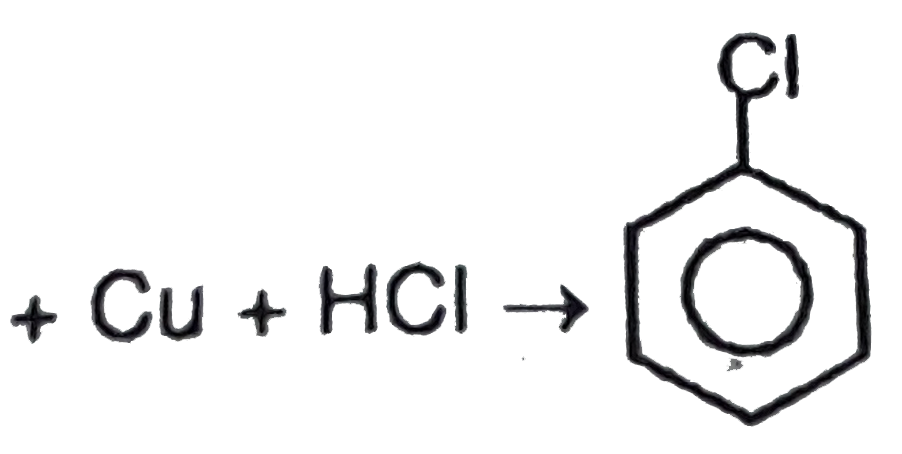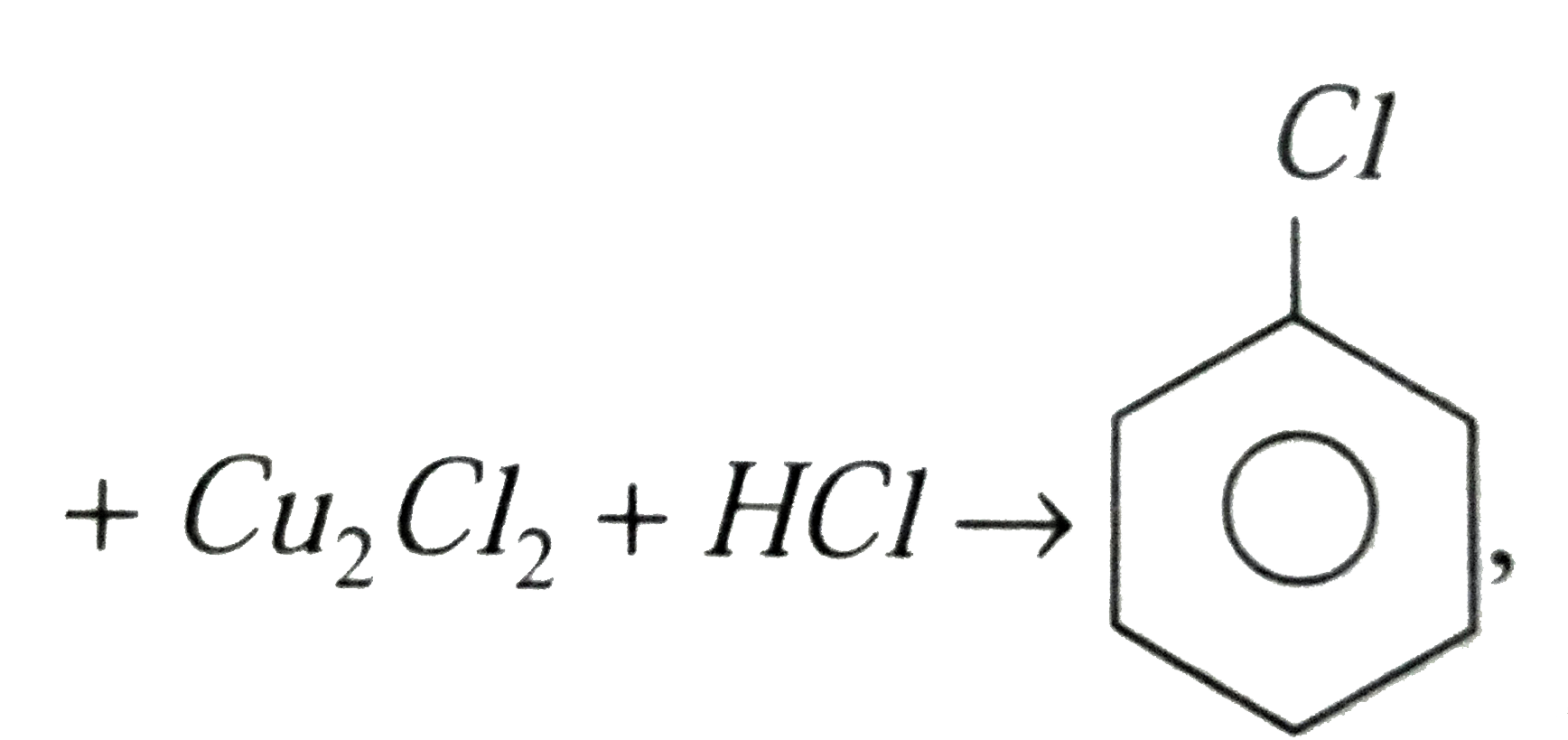Diazonium salt formation and coupling reaction: When a reaction mixture of phenyl amine and nitrous acid is kept below 10∘C, a diazonium salt is formed. This reaction is called diazotization reaction.
_E01_891_Q01.png)
The diazonium ion, −N+2, is rather unstable and decomposes readily to nitrogen. However, delocalization of the diazonium from π−bond electron over a benzene ring phenyl diazonium sufficiently for it to form at low temperature. The phenyl diazonium ion behaves as an electrophile, and will attack another arene molecule such as phenol. Electrophilic subsitiution takes at the 4 position, producing 4-hydroxy phenyl azobenzene. The reaction is known as coupling reaction.
_E01_891_Q02.png)
The compound formed is an energetically stable, yellow azo dye (the azo group is −N=N−) The stability is due to extensive delocalisation of electrons via the nitrogen- nitrogen double bonds.
The azo dye obtained on reacting 4-aminophenol with nitrous acid (in dilute hydrochloric acid) below 10∘C and coupling the resulting diazonium salt with phenol is :
_E01_891_O01.png)
_E01_891_O02.png)
_E01_891_O03.png)
_E01_891_O04.png)
The correct Answer is:C
Topper's Solved these Questions
- ALKENE, ALKANE & ALKYNE BOOK - ALLENCHAPTER - ALKENE, ALKANE & ALKYNE EXERCISE - EXERCISE-4(A)
10 Videos
- ALKENE, ALKANE & ALKYNE BOOK - ALLENCHAPTER - ALKENE, ALKANE & ALKYNE EXERCISE - EXERCISE-4(B)
10 Videos
- ALKENE, ALKANE & ALKYNE BOOK - ALLENCHAPTER - ALKENE, ALKANE & ALKYNE EXERCISE - EXERCISE-1
119 Videos
- AIIMS 2019BOOK - ALLENCHAPTER - AIIMS 2019EXERCISE - CHEMISTRY
35 Videos
- ALKYL AND ARYL HALIDEBOOK - ALLENCHAPTER - ALKYL AND ARYL HALIDEEXERCISE - EXERCISE-05 (B)
37 Videos
Similar Questions
Diazonium salt formation and coupling reaction: When a reaction mixture of phenyl amine and nitrous acid is kept below 10∘C, a diazonium salt is formed. This reaction is called diazotization reaction.
_E01_892_Q01.png)
The diazonium ion, −N+2, is rather unstable and decomposes readily to nitrogen. However, delocalization of the diazonium from π−bond electron over a benzene ring phenyl diazonium sufficiently for it to form at low temperature. The phenyl diazonium ion behaves as an electrophile, and will attack another arene molecule such as phenol. Electrophilic subsitiution takes at the 4 position, producing 4-hydroxy phenyl azobenzene. The reaction is known as coupling reaction.
_E01_892_Q02.png)
The compound formed is an energetically stable, yellow azo dye (the azo group is −N=N−) The stability is due to extensive delocalisation of electrons via the nitrogen- nitrogen double bonds.
Benzene diazonium chloride on reaction with phenol in weakly basic medium gives :
View SolutionDiazonium salt formation and coupling reaction: When a reaction mixture of phenyl amine and nitrous acid is kept below 10∘C, a diazonium salt is formed. This reaction is called diazotization reaction.
_E01_893_Q01.png)
The diazonium ion, −N+2, is rather unstable and decomposes readily to nitrogen. However, delocalization of the diazonium from π−bond electron over a benzene ring phenyl diazonium sufficiently for it to form at low temperature. The phenyl diazonium ion behaves as an electrophile, and will attack another arene molecule such as phenol. Electrophilic subsitiution takes at the 4 position, producing 4-hydroxy phenyl azobenzene. The reaction is known as coupling reaction.
_E01_893_Q02.png)
The compound formed is an energetically stable, yellow azo dye (the azo group is −N=N−) The stability is due to extensive delocalisation of electrons via the nitrogen- nitrogen double bonds.
The product_E01_893_Q03.png) which is a red azodye obtained on reacting benzene diazonium chloride with one of the following compounds :
which is a red azodye obtained on reacting benzene diazonium chloride with one of the following compounds :
View Solution
Knowledge Check
Diazonium salt formation and coupling reaction: When a reaction mixture of phenyl amine and nitrous acid is kept below 10∘C, a diazonium salt is formed. This reaction is called diazotization reaction.
_E01_892_Q01.png)
The diazonium ion, −N+2, is rather unstable and decomposes readily to nitrogen. However, delocalization of the diazonium from π−bond electron over a benzene ring phenyl diazonium sufficiently for it to form at low temperature. The phenyl diazonium ion behaves as an electrophile, and will attack another arene molecule such as phenol. Electrophilic subsitiution takes at the 4 position, producing 4-hydroxy phenyl azobenzene. The reaction is known as coupling reaction.
_E01_892_Q02.png)
The compound formed is an energetically stable, yellow azo dye (the azo group is −N=N−) The stability is due to extensive delocalisation of electrons via the nitrogen- nitrogen double bonds.
Benzene diazonium chloride on reaction with phenol in weakly basic medium gives :Adiphenyl etherBp-hydroxy azobenzeneCchlorobenzeneDbenzeneDiazonium salt formation and coupling reaction: When a reaction mixture of phenyl amine and nitrous acid is kept below 10∘C, a diazonium salt is formed. This reaction is called diazotization reaction.
_E01_893_Q01.png)
The diazonium ion, −N+2, is rather unstable and decomposes readily to nitrogen. However, delocalization of the diazonium from π−bond electron over a benzene ring phenyl diazonium sufficiently for it to form at low temperature. The phenyl diazonium ion behaves as an electrophile, and will attack another arene molecule such as phenol. Electrophilic subsitiution takes at the 4 position, producing 4-hydroxy phenyl azobenzene. The reaction is known as coupling reaction.
_E01_893_Q02.png)
The compound formed is an energetically stable, yellow azo dye (the azo group is −N=N−) The stability is due to extensive delocalisation of electrons via the nitrogen- nitrogen double bonds.
The product_E01_893_Q03.png) which is a red azodye obtained on reacting benzene diazonium chloride with one of the following compounds : A
which is a red azodye obtained on reacting benzene diazonium chloride with one of the following compounds : A_E01_893_O01.png) B
B_E01_893_O02.png) C
C_E01_893_O03.png) D
D_E01_893_O04.png)
Diazonium salt
 , the reaction is known as AChlorinationBSandmeyer's reactionCPerkin reactionDGattermann reaction
, the reaction is known as AChlorinationBSandmeyer's reactionCPerkin reactionDGattermann reaction


 , the reaction is known as
, the reaction is known as , the reaction is known as
, the reaction is known as